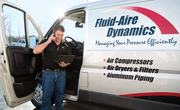Do you need an oil-free air compressor or a lubricated air compressor? Choosing the right type of air compressor is critical for optimal performance, efficiency and product quality. The best air compressor for your industrial applications depends on your air purity requirements as well as other factors like maintenance needs, efficiency and cost. Both oil-free air compressors and lubricated air compressors have unique advantages, drawbacks and applications.
Read on to explore the key differences between these two types of air compressors, their benefits, and how to determine which is best suited for your industrial applications.
What Is an Oil-Lubricated Air Compressor?

An oil-lubricated air compressor (also known as an oil-flooded or oil-injected compressor) uses oil to ensure smooth operation and maintain the efficiency of the air compression process. These industrial air compressors, which include both rotary screw and reciprocating models, rely on moving parts — such as pistons or rotary screws — that require consistent lubrication to minimize wear and tear, reduce friction and prevent overheating. They are built for heavy use and suitable for most industrial applications.

In oil-lubricated air compressors, oil serves several critical functions:
- Lubricates the internal components
- Helps dissipate the heat generated during compression
- Forms a seal to enhance the efficiency of the compression process
Depending on the compressor type, oil may be injected directly into the compression chamber (as in oil-injected compressors) or used to lubricate moving parts outside the chamber. Different types of oil are used in these compressors, including mineral oils and synthetic oils. Choosing the right type of compressor oil depends on the model and your specific operating conditions; always use the oil recommended by your manufacturer.
- Mineral oils are cost-effective but may require more frequent replacement.
- Synthetic oils offer superior thermal stability, longer service life and better performance in demanding environments.
- Food-grade oils are available for use in food applications.
What Is an Oil-Free Compressor?
Oil-free air compressors are designed to operate without using oil for lubrication within the compression chamber. Instead, these compressors rely on alternative lubrication methods such as pre-lubricated materials (e.g., Teflon coatings) or water to reduce heat and friction. These methods not only eliminate the risk of oil contamination but also reduce maintenance requirements and environmental impact.
- Teflon coatings: A dry oil-free compressor uses Teflon or similar materials as a durable, low-friction surface on key components, such as pistons and rotors, allowing the mechanisms to operate seamlessly with minimal wear and tear. The self-lubricating properties of Teflon reduce the need for additional maintenance while ensuring consistent performance and efficiency. Both piston and screw compressors are available as dry oil-free compressors.

- Water-injected oil-free compressors: In these oil-free units, water acts as a dual-purpose agent, serving both as a lubricant and a coolant. This method effectively dissipates the heat generated during the compression process, helping to maintain cooler operating temperatures. Water injection is only used for certain screw compressors and may not be suitable for heavy-duty applications or harsh operating environments.
Oil-free air compressors are ideal for industries requiring contamination-free air, such as food and beverage, pharmaceuticals, and electronics, where maintaining air purity is critical. To achieve optimal performance, oil-free air compressors rely on tight mechanical tolerances in their rotors, which minimizes friction between components. It’s important to note that while the compression chamber is oil-free, other parts of the system, such as bearings or external mechanisms, may still require lubrication.
Key Differences Between Oil and Oil-Free Air Compressors
When choosing between oil vs. oil-free air compressors, understanding the key differences is essential for selecting the right solution for your needs. From lubrication requirements to maintenance costs, contamination risks, noise levels, durability, and energy efficiency, each type has its own strengths and limitations. Below, we break down the most important factors to consider in the oil vs. oil-free air compressor debate.
Comparison of Oil-Lubricated vs. Oil-Free Air Compressors
| Feature | Oil-Lubricated Air Compressors | Oil-Free Air Compressors |
|---|---|---|
| Air Quality | May have oil carryover; not suitable for sensitive applications without substantial air treatment | Provides clean, oil-free air; ideal for food, beverage and pharmaceutical industries |
| Maintenance | Requires regular oil changes and filter replacements | Lower maintenance; no oil management required |
| Durability | Highly durable; built for heavy-duty applications | Less durable in heavy-duty use |
| Noise Levels | Quieter due to lubrication damping | Historically noisier, but modern designs have improved noise reduction |
| Energy Efficiency | May consume more energy due to oil circulation and cooling requirements | Often more energy-efficient, reducing power costs |
| Environmental Impact | Requires proper oil disposal and filtration; risk of leaks and contamination | Eco-friendly, no oil disposal needed, lower contamination risk, and often more energy-efficient |
| Heat Generation | Generates more heat; requires robust cooling systems | Often generates less heat; simpler cooling mechanisms |
| Contamination Risk | Risk of oil contamination in compressed air without treatment | No risk of oil contamination |
| Applications | Manufacturing, construction, automotive, and other heavy-duty industries | Sensitive applications like food processing, healthcare, and electronics |
| Upfront Cost | Lower purchase price | Higher purchase price |
| Total Cost of Ownership | Higher maintenance and operating costs are offset by better longevity and reliability. | May have lower operating costs due to reduced maintenance and improved energy efficiency, but higher repair costs and downtime |
Lubrication Requirements
Oil-lubricated compressors rely on oil as the primary lubrication medium to reduce friction between moving parts, prevent wear, and dissipate heat. Regular oil changes and filter replacements are required to maintain performance, and operators must monitor oil levels consistently. In contrast, oil-free air compressors use alternative lubrication methods, such as Teflon coatings or water, eliminating the need for manual lubrication. This reduces maintenance complexity and eliminates the risk of oil contamination.
Maintenance Needs and Costs
Oil-lubricated compressors typically require more maintenance due to the need for oil changes, filter replacements, and frequent monitoring. These maintenance tasks contribute to higher long-term maintenance costs and a greater time commitment. Oil-free compressors require little regular maintenance, as they eliminate the need for oil management.
Contamination Risks
One of the most significant considerations in the oil vs. oil-free air compressor comparison is the risk of oil contamination. Oil-lubricated compressors carry the possibility of oil carryover into the compressed air, which can compromise product quality in industries like food, beverage and pharmaceuticals. In these sensitive environments, where clean compressed air is critical, oil-free air compressors are the preferred choice. They ensure air purity, meeting stringent health and safety standards. Contamination risks for oil-lubricated compressors can be minimized with appropriate air treatment, including inline filtration and air dryers. (Read more: Reducing Oil Carryover in an Oil-Flooded Air Compressor.)
Noise Levels
Oil-lubricated air compressors are generally quieter due to the lubricating oil’s ability to dampen sound produced by moving parts. However, oil-free compressors, while historically noisier, have benefitted from advancements in noise reduction technology, making many modern oil-free models comparable in noise levels to their oil-lubricated counterparts.
Durability and Longevity
Oil-lubricated air compressors are often designed for heavy-duty applications and are highly durable, making them ideal for continuous, heavy-duty work in demanding industrial settings. Their lubricated components typically experience less wear over time, resulting in a longer lifespan when properly maintained.
Energy Efficiency and Heat Generation
Oil-free air compressors are often more energy-efficient, as they eliminate the energy losses associated with oil circulation systems. Additionally, some oil-free designs (especially water-injected) generate less heat, reducing the need for extensive cooling mechanisms. Oil-lubricated compressors, while often more reliable and efficient for heavy-duty applications, tend to produce more heat and may require more robust cooling systems to maintain performance.

Applications for Oil and Oil-Free Air Compressors
Choosing the right type of air compressor depends on the specific requirements of your industrial application. Oil-lubricated and oil-free air compressors each offer unique advantages, making them suitable for different industries and tasks. In general, oil-free units are recommended for applications that require ultra-clean compressed air, while lubricated units provide better value, longevity and performance for general manufacturing and heavy-duty industrial applications. However, it is important to note that oil-lubricated compressors can often be used for applications requiring high air purity, such as food and pharmaceuticals, with the right combination of air treatment strategies.
Below, we highlight applications for oil vs. oil-free air compressors and where each compressor type excels.
Oil-Lubricated Air Compressor Applications
Oil air compressors, also called oiled air compressors or oil-based compressors, are built for heavy-duty applications where durability and power are critical. These compressors are commonly used in industries where air purity is not a primary concern, offering excellent performance in demanding environments.
- Manufacturing: Ideal for powering pneumatic tools, machinery, and assembly lines in factories.
- Construction: Provides reliable air supply for jackhammers, nail guns, and other equipment on job sites.
- Automotive repair: Powers tools like impact wrenches and paint sprayers in garages and body shops.
-
Heavy equipment maintenance: Handles high-pressure tasks in industries such as mining and transportation.
Oil-Free Air Compressor Applications
Oil-free air compressors, also referred to as oil-free models or oil-less designs, are essential in industries where air purity is critical to ensuring product quality and safety. These compressors meet stringent cleanliness standards and eliminate the risk of oil contamination.
- Pharmaceuticals: Ensures contamination-free air for manufacturing medications and medical devices.
- Food & beverage: Supplies clean air for food packaging, bottling and processing operations.
- Electronics: Protects sensitive components during assembly and testing processes.
- Healthcare: Delivers pure air for equipment like ventilators, dental tools and surgical instruments.
- Textiles: Maintains air purity during fabric production to prevent damage or contamination.
Factors to Consider When Choosing Between Oil vs. Oil-Free Air Compressors
Selecting the right air compressor for your industrial application requires careful evaluation of several key factors. Your decision will depend on your primary concern or concerns, such as air quality requirements, maintenance needs, production downtime and budget. Below, we break down these considerations to help you determine the best option for your business.
Air Quality Requirements
Air quality is a critical factor in many industries, especially those requiring clean air with minimal or no oil content. By understanding your industry’s air purity needs, you can decide whether a compressor that eliminates oil contamination is necessary for your operation.
- Sensitive industries: Food, beverage, pharmaceutical and electronics manufacturing often have stringent air quality standards to prevent contamination. For these industries, oil-free air compressors are essential to meet regulatory requirements and maintain product integrity.
- General applications: For industries like construction or automotive repair, where air quality is less critical, oil air compressors may provide sufficient performance without the added cost of oil-free technology.
Maintenance and Downtime
The maintenance requirements of your compressor directly impact operational efficiency and production downtime.
- Oil-lubricated compressors: These require regular oil changes, filter replacements, and frequent monitoring of oil levels, which can lead to more frequent downtime for servicing. While they are durable and well-suited for heavy-duty applications, the ongoing maintenance can increase costs and disrupt production schedules.
- Oil-free compressors: With no oil to manage, these compressors have lower maintenance requirements, reducing the frequency and cost of servicing. This can help minimize production downtime, especially in industries that require continuous operation. However, they may have more frequent breakdowns, resulting in downtime and repair bills.
Budget and Total Cost of Ownership
When evaluating compressors, it’s essential to consider not just the upfront purchase price but the total cost of ownership, which includes maintenance, energy efficiency and operational costs. Consider:
- Upfront costs: Oil air compressors often have a lower initial cost, making them a more accessible choice for businesses on a tight budget.
- Maintenance costs: Over time, the cost of oil changes, filter replacements and additional labor for oil-lubricated compressors can add up. Oil-free compressors typically have lower maintenance costs, which can offset their higher purchase price.
- Energy efficiency: Oil-free compressors are often more energy-efficient, reducing power consumption and lowering operating costs. Energy savings can reduce the total cost of ownership over the life of the compressor.
- Longevity: Oil-lubricated compressors tend to last significantly longer, especially in heavy-duty applications, because the oil reduces wear and tear on moving parts. Oil compressors offer better performance and longevity in continuous applications.
- Reliability and repair costs: An oil-free compressor, while eliminating the hassles of oil-related maintenance, may be prone to more frequent breakdowns. Repairs may also be more expensive due to their specialized precision components.
Choosing the Right Air Compressor for Your Industrial Application
Selecting the right air compressor for your industrial application requires a careful evaluation of your operational needs, priorities, and long-term goals. The decision between oil-lubricated and oil-free compressors depends on several factors that impact performance, maintenance, and cost-effectiveness.
- Air quality requirements: If your industry requires exceptionally clean air, such as in pharmaceuticals, food, and electronics, an oil-free compressor is essential to eliminate the risk of contamination. For applications where air purity is less critical, an oil-lubricated compressor may provide a cost-effective and reliable solution.
- Maintenance and downtime: Consider how much time and budget you can allocate for maintenance. Oil-lubricated compressors require regular oil changes and filter replacements, while oil-free compressors reduce maintenance tasks and minimize production interruptions.
- Budget and total cost of ownership: Assess both upfront costs and long-term expenses, including maintenance costs, energy efficiency, reliability and the expected lifespan of the compressor. Oil-lubricated compressors typically last longer in heavy-duty applications, but oil-free models can reduce operational costs in industries where air purity is a top priority.
- Application demands: Evaluate the specific requirements of your application, including air pressure, duty cycle and environmental conditions. Oil-lubricated compressors are ideal for heavy-duty tasks, while oil-free compressors excel in sensitive and specialized environments.
By carefully weighing these factors, you can select the compressor type that best meets your operational needs and ensures maximum efficiency and reliability in your industrial application. The right air compressor will not only support your current production demands but also provide long-term value for your business.
Trust Fluid-Aire Dynamics as Your Air Compressor Resource
When it comes to selecting the best air compressors for your industrial applications, Fluid-Aire Dynamics is your trusted partner. With decades of experience in the industry, we specialize in helping businesses like yours find the right compressed air solutions to meet your specific needs. Whether you require an oil-lubricated model for heavy-duty operations or an oil-free compressor for sensitive, high-purity applications, our team has the expertise to guide you through the decision-making process.
At Fluid-Aire Dynamics, we understand that every business is unique. That’s why we take the time to evaluate your application requirements, operational priorities and long-term goals to provide personalized recommendations. From compressed air system design and optimization to ongoing air compressor preventative maintenance and support, we’re here to ensure your air system delivers optimal performance and reliability.
Contact Fluid-Aire Dynamics today for expert assistance in choosing the perfect air compressor for your business.






